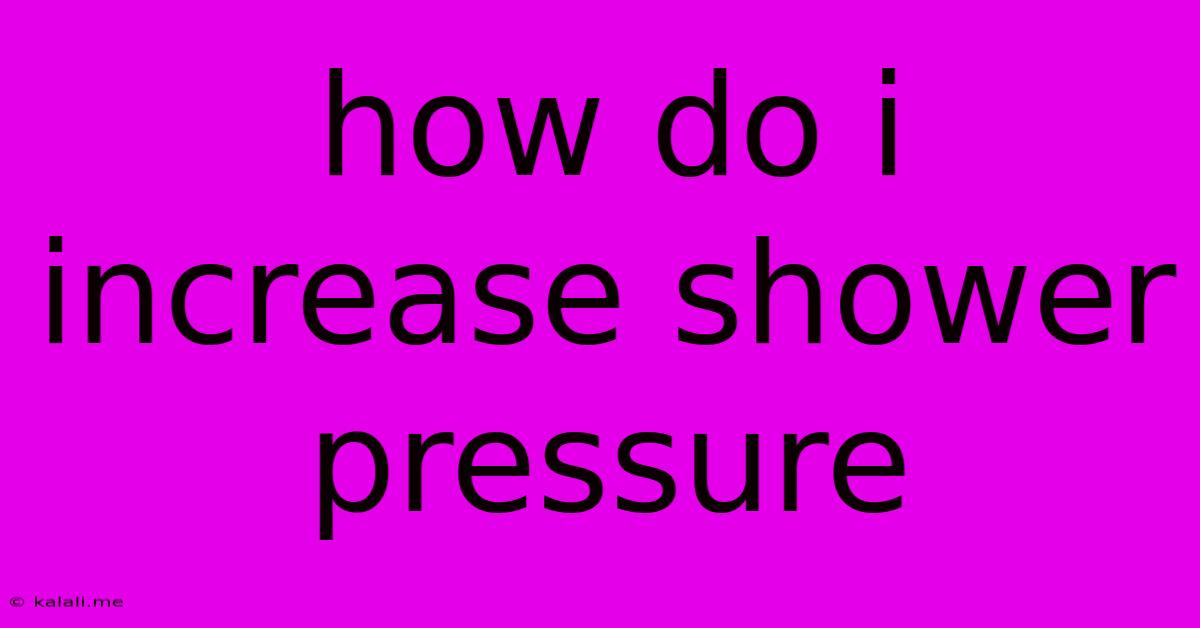How Do I Increase Shower Pressure
Kalali
May 21, 2025 · 3 min read

Table of Contents
How to Increase Shower Pressure: A Comprehensive Guide
Low shower pressure is a frustrating problem, leaving you feeling anything but refreshed. But before you call a plumber, there are several things you can try yourself to boost that pressure. This guide explores common causes of low shower pressure and offers practical solutions, helping you achieve a powerful and invigorating shower experience.
Why is my shower pressure low? Understanding the root cause is crucial for effective problem-solving. Several factors can contribute to a weak shower stream, including mineral buildup, a faulty showerhead, low water pressure throughout your home, or issues with your water heater.
Diagnosing the Problem: Is it your showerhead or your whole house?
The first step is determining if the low pressure is isolated to your shower or affects other fixtures. Check your kitchen and bathroom faucets. If they also have low pressure, the problem likely lies within your home's plumbing system. If only your shower is affected, the issue probably lies with the showerhead itself.
Solutions for Low Shower Pressure
Let's explore the most effective ways to increase your shower pressure, categorized for clarity:
1. Cleaning Your Showerhead:
-
Mineral Buildup: This is a very common culprit. Hard water deposits limescale and minerals, restricting water flow. To clean it:
- Vinegar Soak: Fill a plastic bag with white vinegar, submerge the showerhead (remove it if possible), and secure the bag with a rubber band. Let it soak for several hours or overnight. Scrub gently with a brush or old toothbrush to remove loosened deposits.
- Boiling Water: If a vinegar soak isn't enough, try immersing the showerhead in boiling water for a few minutes.
- Commercial Cleaners: Use a descaling solution specifically designed for showerheads, following the product instructions carefully.
-
Debris: Remove the showerhead and check for any debris clogging the spray nozzles. Use a small pin or needle to clear any blockages.
2. Replacing Your Showerhead:
-
Low-Flow Showerheads: These are designed to conserve water but can result in lower pressure. Consider upgrading to a high-pressure showerhead, specifically designed for optimal water flow even with lower water pressure. Look for showerheads with features like larger spray faces and multiple spray settings. Consider the flow rate (GPM) - a higher GPM generally means more pressure.
-
Faulty Showerhead: Even if not a low-flow model, a damaged or worn-out showerhead can significantly reduce pressure. Replacing it with a new, high-quality showerhead is a simple and often effective solution.
3. Addressing Whole-House Water Pressure Issues:
If low pressure affects multiple fixtures, the problem extends beyond your showerhead. Several solutions exist:
- Check Your Water Meter: Make sure your water meter is running freely and isn't obstructed.
- Inspect Your Pipes: Look for leaks, kinks, or blockages in your main water supply line.
- Water Pressure Regulator: If you have a pressure regulator, ensure it's set correctly. Adjusting it might increase the overall water pressure in your house. (Consult a professional if unsure.)
- Sediment Buildup: Sediment accumulation in your pipes can restrict water flow. This might require professional cleaning or pipe replacement.
- Water Heater: A malfunctioning or undersized water heater can also cause low water pressure.
4. Consider a Water Pressure Booster Pump:
For persistent low water pressure, a booster pump can significantly improve pressure throughout your home. This is a more advanced solution requiring professional installation, but it's a highly effective option for consistently low water pressure.
Conclusion:
Increasing your shower pressure often involves a simple fix, such as cleaning or replacing your showerhead. However, if the issue stems from your home's plumbing system, professional assistance might be necessary. By systematically diagnosing the problem and implementing these solutions, you can enjoy a powerful and refreshing shower experience once again. Remember to always prioritize safety when working with plumbing. If you're unsure about any aspect of this process, consult a qualified plumber.
Latest Posts
Latest Posts
-
Fallout 4 The Road To Freedom
May 21, 2025
-
How Did Wolverine Get His Claws Back
May 21, 2025
-
How To Wire A Pull Light Switch
May 21, 2025
-
Amulet Of Proof Against Detection And Location
May 21, 2025
-
Push Me Pull Me Dr Dolittle
May 21, 2025
Related Post
Thank you for visiting our website which covers about How Do I Increase Shower Pressure . We hope the information provided has been useful to you. Feel free to contact us if you have any questions or need further assistance. See you next time and don't miss to bookmark.